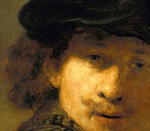
"The Incredulity of Saint Thomas"
According to the Gospel of John, Thomas the Apostle missed one of Jesus's appearances to the Apostles after his resurrection, and said "Unless I see the nail marks in his hands and put my finger where the nails were, and put my hand into his side, I will not believe it." A week later, Jesus appeared and told Thomas to touch him and stop doubting. Then Jesus said, "Because you have seen me, you have believed; blessed are those who have not seen and yet have believed."
The painting shows in a demonstrative gesture how the doubting apostle puts his finger into Christ's side wound, the latter guiding his hand. The unbeliever is depicted like a peasant, dressed in a robe torn at the shoulder and with dirt under his fingernails. The composition of the picture is such that the viewer is directly involved in the event and feels the intensity of the process.
The light falling on Christ emphasises his physicality and at the same time suggests his divinity and significance to the viewer. Caravaggio was a master of light and shadow, and he uses this chiaroscuro to create a narrative through line in this piece. The shadows (representing doubt) sweep over St. Thomas, but as he touches Christ he is drawn into the light.
The painting features heavy chiaroscuro. Thomas's face shows surprise as Jesus holds his hand and guides it into the wound. The absence of a halo emphasizes the corporeality of the risen Christ. Behind Thomas are two other apostles, probably Saint Peter and Saint John the Evangelist.
Caravaggio, in the horizontal dimension of the canvas, "photographs" the moment of observation in a three-quarter frame in which he arranges the four figures on a neutral and dark background. This allows the viewer's attention to be focused on Thomas' head, while the light illuminates Christ's forehead, profile and clear side, allowing us to draw attention to the anxious and unsettled posture of Thomas, who is being comforted by Christ and to whom he bends his head. The close arrangement of the four heads and a triangle of gazes, with the focus on Thomas' gesture, allows for a further emotional concentration of the viewer's gaze, which can now focus on the center of the "drama": the revelation of the real presence in the flesh of Jesus. Caravaggio shows the apostle Thomas who, following a certain iconographic tradition, sticks a finger into Jesus' spear wound while two other apostles observe the scene. The facial expression of Christ can only be compared in simplicity and beauty to Leonardo's Mona Lisa. Also on the compositional level we observe the intersection of two main axes, the horizontal one consisting of the arm of Thomas and the hands of Jesus and the vertical one running from the head of the two apostles (or better between both heads) and continuing exactly at the neck of the apostle Thomas. This arrangement is rounded off by an arch formed by the two backs of Thomas and Christ: An admirable interlocking of human forms "thrown" into the foreground, with great emotional impact. The gesture of Thomas and the hand of Christ that accompanies him explode in an extraordinary "zoomata", enhanced by the light coming from the left (the light of Revelation) that illuminates the doubt, the astonishment (in the fronts of the apostles) and the reality of the living flesh of the Saviour